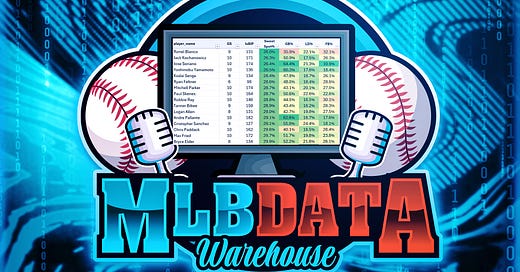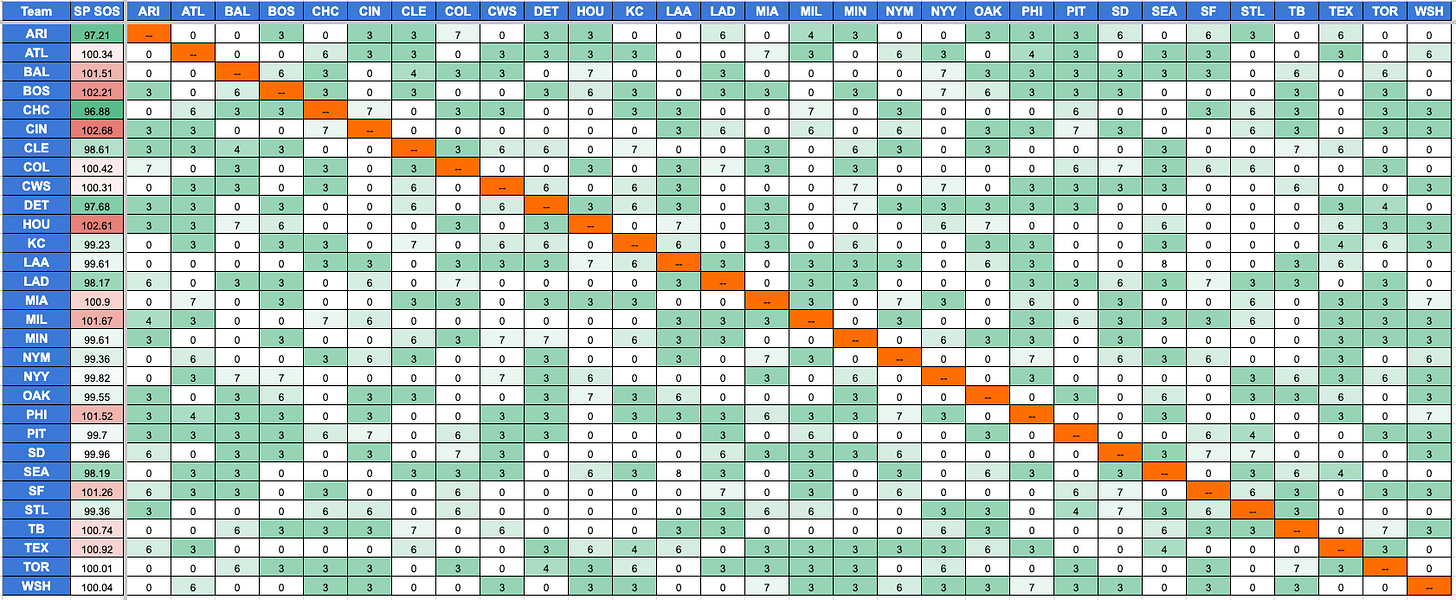Second Half Pitchers to Monitor
I go through a bunch of potential second half breakout SPs to help our fantasy teams in the second half
Strength of Schedule
Here’s a massive table breaking down each team’s remaining schedule. I merged in my offensive grades and averaged out each team’s strength of remaining schedule for pitchers. You can click here to get the full view.
When you’re looking at 60+ games, things tend to even out. I normalized it on a 100 scale, and the range we have is basically from 103 to 97, a pretty small six-point range. The toughest schedule will only be 3% tougher than average, and vice versa.
We also have to point out that a team schedule doesn’t necessarily correlate with an individual pitcher's schedule. If you’re going into a three-game set with the Rockies, your individual pitchers only have a 60% chance of actually facing that offense. But this is about as good as we can do, and it’s useful to look at.
Five schedules stand out as advantageous for the team’s starting pitchers.
Cubs
Diamondbacks
Tigers
Dodgers
Mariners
The Cubs completely avoid the Dodgers and Yankees; they see the Mets just once, and they get six games with the Pirates and then a series with the Angels, Royals, White Sox, Rockies, and a number of other average or mediocre team offenses.
The Diamondbacks get two series with the Dodgers, but other than that, they’re in good shape.
Your five toughest schedules:
Reds
Astros
Red Sox
Brewers
Phillies
It’s silly to make SP decisions for your fantasy team based on this for the reasons I gave at the beginning, but that doesn’t mean it’s useless to look at. Maybe you could use it as a tiebreaker of sorts.
Now let’s get into some arms that are available in fantasy leagues, which I think could be difference-makers down the stretch.
Emmet Sheehan, Dodgers
The hesitation on Sheehan is the question about how the Dodgers will use him. The LA rotation is getting healthy fast with Glasnow back in the rotation, Ohtani built up to 3+ innings, and Snell returning soon as well.
When everybody is healthy, Sheehan is clearly not a top-five option for them. But it’s hard to believe this rotation can stay fully healthy for any significant period of time, so I think we’ll see Sheehan throw a good number of innings in the second half. His season so far:
That’s a big 15% SwStr% with a non-awful 36.5% Ball%. He has a good fastball along with a slider and changeup combo behind it. I do think this guy can hang in the Major Leagues. It’s just a question of whether he’ll be making traditional starts or not. We last saw him throwing 55 pitches following Shohei Ohtani. Being a bulk guy isn’t a bad thing to see, but pretty soon Ohtani will be handling 5-6 innings by himself, so that role isn’t for long.
Yamamoto
Glasnow
Ohtani
Kershaw
May
Snell
Sheehan
But if something breaks again and Sheehan is back in a traditional starters role for the Dodgers, I’d call him pretty close to must-own. You’ll just have to keep an eye on the news coming out of that situation.
Brandon Walter, Astros
Walter lit it up in AAA in his 11 starts down there (27.5% K%, 4.5% BB%, 2.49 JA ERA, 1.17 WHIP+), and that got him a call-up into the Astros rotation. Here are the numbers for MLB Walter so far:
24.2% K%, 1.2% BB%, 13% SwStr%, 49% Strike%, 32% Ball%, 2.59 JA ERA
That’s a 23% K-BB% in seven starts. And we have a rule here that you automatically add any pitcher with a 20% K-BB% in at least five starts. It doesn’t always maintain, but it’s about as good a sign as anything that a guy might be able to have consistent success in the Majors.
The schedule has been soft, and that has no doubt helped him.
TB, CLE, MIN, LAA, CHC, COL, CLE
It hasn’t been steady production from Walter so far. He gave up seven earned runs to the Angels and five more in Coors Field to the Rockies. But he handled himself quite well against the Cubs and has four quality starts in his seven outings.
Another reason to hesitate is the lack of fastball velo. He can barely touch 93mph. His primary pitch, the cutter, averages just 88.
So he relies on deception and command to get his strikeouts, and that’s not something we typically want to bank on moving forward.
But it’s mid-July, and it’s hard to find good pitchers. We are taking on at least one flaw in every guy we’re talking about here. Overall, though, Walter looks pretty good.
First paywall of the second half coming up! Join on for $12/month for the rest of the season to get everything I’m doing. It’s going to be a fun last few months.







